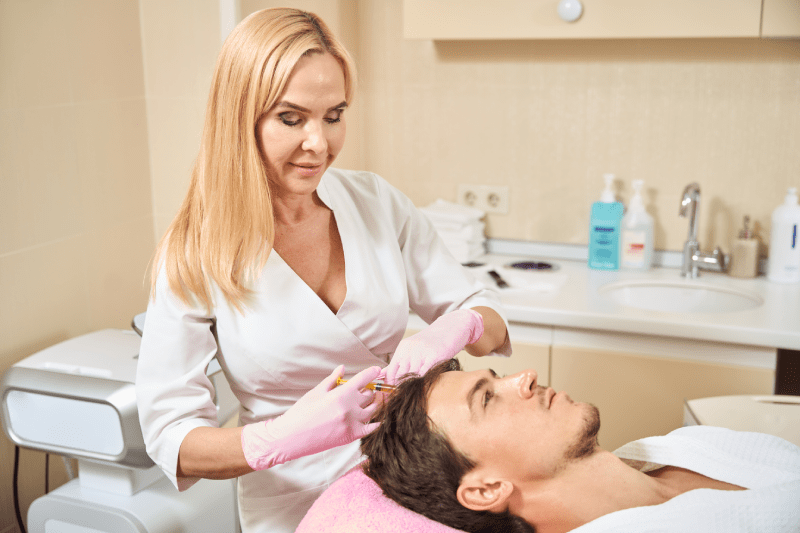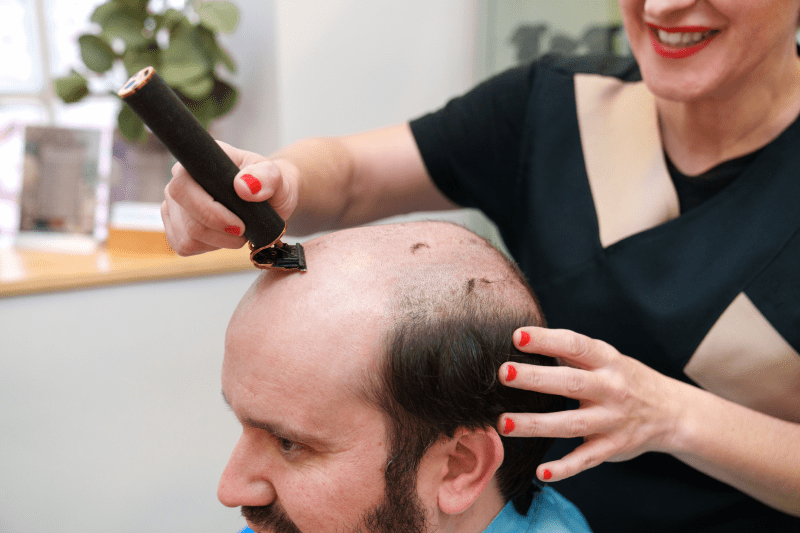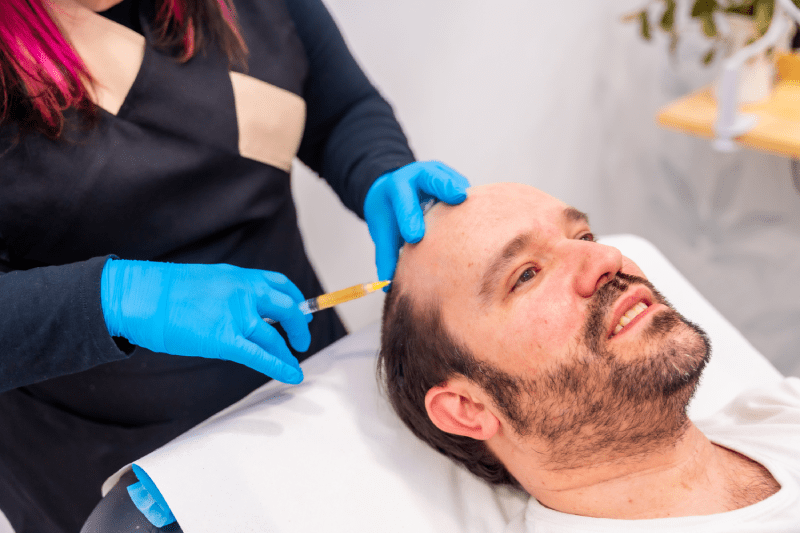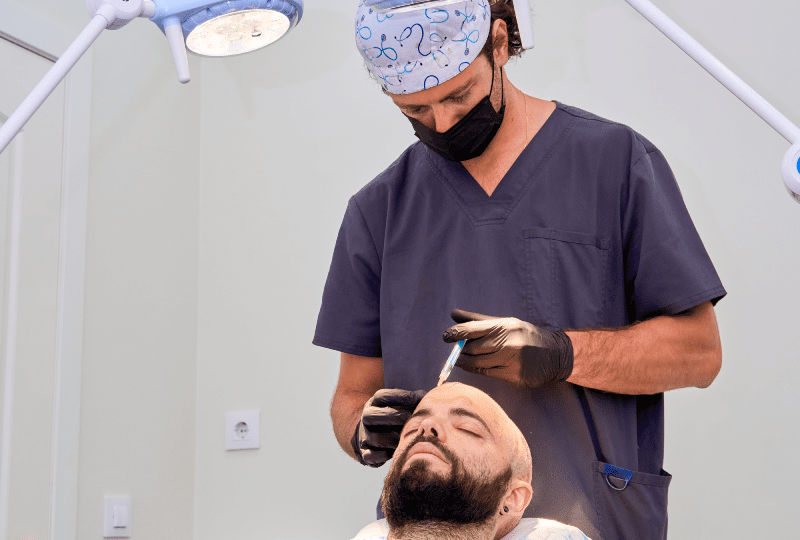Hair loss is not just a physical change; it’s also an emotional process that directly impacts a person’s self-confidence and social life. The most permanent and effective solution offered by modern medicine to combat alopecia (hair loss), a common problem for millions of men and women, is undoubtedly hair transplantation.
However, when making this important aesthetic and medical decision, two major options emerge: Western clinics near you (such as Manchester, England) or Turkey, the global leader in health tourism, hosting thousands of successful operations.
What is Hair Loss and What are the Treatment Options?
Hair loss (Alopecia) is the condition where hair sheds more than normal, meaning more than 100 strands per day. Understanding the underlying causes and current treatment methods is the first step toward the decision for a hair transplant.
Fundamental Causes of Hair Loss
- Androgenetic Alopecia (Male Pattern Baldness):
- This is the most common cause, resulting from genetic predisposition and sensitivity to the hormone Dihydrotestosterone (DHT). It is characterized by a receding hairline and thinning at the crown.
- Hormonal Changes:
- This can be seen in women due to conditions like pregnancy, menopause, or Polycystic Ovary Syndrome (PCOS). Thyroid problems also lead to hair shedding.
- Stress and Lifestyle:
- Excessive physical or emotional stress can lead to temporary hair shedding called Telogen Effluvium, which pushes hair follicles into the resting phase.
- Nutritional Deficiencies:
- Deficiencies in iron, zinc, Vitamin B12, Vitamin D, and protein reduce hair quality and increase shedding.
- Skin Diseases and Medications:
- Fungal infections (Tinea Capitis) or certain autoimmune diseases (Alopecia Areata) can also cause regional hair loss.

Non-Surgical Treatment Options for Hair Loss
While hair transplantation is a permanent solution, some non-surgical treatments are available for early stages of hair loss or to support a transplant:
- Minoxidil (Topical Medication):
- A vasodilator applied to the scalp that increases blood flow and extends the hair follicle life cycle. It slows down shedding and helps thicken existing hair.
- Finasteride (Oral Medication):
- A 5-alpha reductase inhibitor that reduces the production of the DHT hormone, which causes male pattern baldness. It should only be used by men and under doctor’s advice.
- PRP (Platelet-Rich Plasma) Treatment:
- A procedure involving the injection of plasma, which is separated from the patient’s own blood and enriched with growth factors, into the scalp. It revitalizes weak hair follicles and improves hair quality.
- Mesotherapy:
- The process of delivering a cocktail of vitamins, minerals, and amino acids needed by the hair follicles directly into the scalp using micro-needles.
Hair Transplant Methods and Frequently Asked Questions
Hair transplantation is generally the procedure of transferring healthy hair follicles taken from the nape area (donor area) to the bald or thinning area (recipient area). The technology used directly affects the naturalness of the result and the speed of recovery.
Comparison of Hair Transplant Methods
| Method | Description | Advantages | Disadvantages |
|---|---|---|---|
| FUE (Follicular Unit Extraction) | Follicles are extracted one by one using a micro-motor and implanted after channels are opened. | Scarless, no stitches, fast recovery. | Can be time-consuming for large areas, manual channel opening requires experience. |
| DHI (Direct Hair Implantation) | Follicles are extracted with a special pen (Choi Implanter Pen) and implanted directly without pre-opening channels. | Allows for unshaven transplantation, precise implantation angle, denser packing possible. | More expensive than FUE, placing follicles into the pen is a delicate process. |
| Sapphire FUE | Micro-channels are opened using sharp sapphire-tipped blades instead of metal. | Less tissue trauma, faster healing, denser and more natural implantation. | Slightly more costly than traditional FUE. |
15 Frequently Asked Questions and Answers About Hair Transplantation
Here, we answer the most common questions on the minds of anyone considering a hair transplant:
Is hair transplantation permanent?
Yes, the hair transplant procedure offers an extremely permanent solution, and the primary reason for this permanence is the genetic structure of the nape area, which is where the transplanted follicles are harvested from. Nape follicles are resistant to Dihydrotestosterone (DHT), the hormone that causes male pattern baldness, meaning they do not carry the shedding genetics.
These resistant follicles retain their characteristics even when transferred to their new location. Successfully transplanted hair follicles continue to grow in their new spots for a lifetime, with proper care and a healthy lifestyle. This makes hair transplantation the most reliable and long-term investment against hair loss.
Will it be obvious that I had a hair transplant?
The success of a hair transplant is measured by achieving a natural look, and with modern techniques, this is almost completely possible. The key to naturalness is the experienced team’s design of the hairline to suit the patient’s facial features, age, and forehead muscles.
Furthermore, placing the follicles at the correct angles during implantation is crucial; hair should be implanted at the natural exit angle of 40-45 degrees. This meticulous planning and application ensure that once healing is complete, the transplanted hair is indistinguishable from the surrounding natural hair, thereby preventing the operation from being noticeable from the outside.

How long does the recovery process take?
The most critical phase of the recovery process is the first 10 days. During this period, the scabs formed in the implantation and donor areas slowly shed according to the first washing instructions, and the follicles anchor into their new places.
Although superficial healing (reduction of redness and swelling) occurs within a few weeks, the adaptation and strengthening of the hair follicles beneath the skin take longer. The first new hairs typically start to emerge on the skin’s surface from the 3rd month after the operation; this demonstrates that the process requires patience and highlights the importance of regular follow-up until the final result is achieved.
When will I see the full results?
A large portion of the transplanted hair usually experiences temporary shedding, known as “shock loss,” 2 to 4 weeks later; this is a normal response of the follicles entering the resting (telogen) phase, and there is no need to worry.
Following this shedding, the hair usually starts to regrow as baby hair around the 3rd month and gains density. A noticeable increase, thickening, and shaping of the hair are observed from the 6th month onwards, but it takes 12 to 18 months for the hair follicles to fully mature and achieve their natural density and thickness. You will patiently attain the final, expected natural appearance by the end of this period.
Will I feel pain during the hair transplant procedure?
The hair transplant is essentially a pain-free procedure because the area is completely numbed with local anesthesia. The only discomfort the patient might feel is during the injection phase of the anesthesia. However, many modern clinics in Turkey use needle-free anesthesia (pressurized jet injection) to eliminate even this momentary pain.
This maximizes procedural comfort. Post-operation, a slight soreness might be felt, but this is easily controlled with standard painkillers prescribed by the doctor and usually completely resolves within a few days, allowing patients to quickly return to their daily lives.
Who is a suitable candidate for a hair transplant?
Suitability for a hair transplant primarily depends on the patient’s general health status and the quality of their donor area. It is essential that the candidate has completed their physical development (generally 20 years and older) and possesses sufficient, healthy hair follicles in the donor area (nape and/or beard). The quality and density of these follicles directly impact the fullness achieved after the transplant.
Additionally, there must be no uncontrolled chronic diseases (severe diabetes, high blood pressure, clotting disorders) or active skin diseases that could impede the operation. Comprehensive blood tests and a doctor’s examination are mandatory before the operation to confirm the candidate’s suitability.
How many grafts are needed for an ideal hair transplant?
The ideal number of grafts is determined through a personalized analysis, based on the Norwood scale, which measures the severity of hair loss. The number of grafts is calculated by specialists according to the width of the recipient area, the current hair density, and the desired final fullness. Generally, 2000-3000 grafts might be sufficient for those with slight thinning in the temples and hairline, while advanced loss covering large openings and the crown may require 5000-6000 grafts or even more.
Experienced specialists meticulously calculate the most appropriate number of grafts to ensure both maximum fullness and to avoid damaging the donor area. In cases of very high graft needs, the procedure may be planned in two separate sessions to protect the donor area.

Will hair grow back in the donor (harvest) area?
No, the hair follicles extracted from the donor area during the transplant, along with their root cells, cannot grow back at that spot. This makes the careful and intelligent utilization of the donor area vital. A successful hair transplant team aims to harvest the hair follicles in a homogeneous and sparse manner throughout the donor area, preventing the appearance of baldness or a patchy look.
The goal is to preserve the aesthetic integrity of the donor region by only slightly reducing the hair density there, so that the remaining healthy hair can easily camouflage the areas where follicles were taken, rendering it unnoticeable even when the hair is cut short.
Will there be a scar after the hair transplant?
When modern FUE and DHI techniques are applied, the risk of a permanent and noticeable scar is nearly zero. Since the micro-needles or punches used in these methods are extremely small, ranging from 0.6 mm to 1.0 mm in diameter, only pinpoint scars form in the donor area.
These scars fade to skin color within a few weeks and are not visible even with short hair, offering the patient freedom in choosing their hairstyle. In contrast, the older FUT (Follicular Unit Transplantation) method resulted in a permanent, visible linear scar on the nape because a strip of skin was removed. FUE and DHI techniques have virtually eliminated this risk today.
How long does the hair transplant procedure take?
The total duration of the hair transplant operation generally ranges from 5 to 9 hours, depending on the number of grafts to be implanted, the method used (FUE, DHI, Sapphire FUE), and the speed of the operating team.
The procedure consists of main stages: local anesthesia, extraction of the follicles, opening the channels, and finally, implanting the follicles. Especially extensive transplants involving over 5000 grafts can take longer and require meticulous attention. The patient is kept comfortable throughout this long period with breaks for rest and nutrition; avoiding haste and maintaining meticulous work at every stage is the most important rule for a successful operation.
What is the most suitable age for a hair transplant?
While there is no definitive upper age limit for a hair transplant, the recommended lower age limit is typically around 20-25 years old. The main reason for this is that the hair loss pattern may not have fully stabilized at a younger age. If a transplant is performed while shedding is ongoing, the surrounding original hairs may continue to fall out even though the transplanted hair is permanent, leading to an unnatural appearance later on.
To prevent this and for long-term planning, it is advisable to wait until the shedding stabilizes or to have a professional hair analysis around age 25 to evaluate future shedding potential, thereby minimizing the need for a second session.

When can I exercise after the hair transplant?
The return to sports and physical activity after a hair transplant must be gradual. In the first week, only very light walking is allowed to prevent the implanted follicles from shifting and to reduce the risk of swelling. Heavy exercise, weightlifting, intense cardio causing excessive sweating, or activities posing a risk of head trauma should be strictly avoided for at least 1 month.
Excessive sweating can increase the risk of infection and cause scabs to shed prematurely, while increased blood pressure can lead to bleeding in the recipient area. This 1-month resting period is mandatory for the follicles to successfully take root and for the healing process to be completed.
Does smoking and drinking alcohol affect the results after a hair transplant?
Yes, smoking and alcohol consumption are among the most significant factors that negatively affect hair transplant results. Nicotine and carbon monoxide in cigarette smoke constrict blood vessels and reduce the blood’s oxygen-carrying capacity.
This makes it difficult for the oxygen and nutrients needed by the newly transplanted hair follicles to reach the recipient area, thereby reducing the success rate of follicle anchoring. Alcohol, on the other hand, thins the blood, which can increase the risk of bleeding during and after the operation, and also prolongs the healing process. For this reason, these substances must be strictly avoided for at least 10 days before and after the operation.
When can I wash my transplanted hair?
The first wash of the transplanted hair is a vital step for the success of the operation and is usually demonstrated or performed by clinic personnel on the 3rd or 4th day after the procedure. The initial wash aims to gently clean the clots and scabs formed in the recipient area.
Special shampoos and lotions are also prescribed for subsequent washes the patient will perform at home. The most crucial rule during this process is to avoid high-pressure water and to gently massage with the fingertips in a dabbing motion, never using fingernails, to avoid damaging the transplanted follicles. This delicate care ensures that the follicles properly take root.
Who cannot undergo a hair transplant?
A hair transplant may not be suitable for individuals with certain medical conditions. This primarily includes those without sufficient density and quality of hair follicles in the donor area; inadequate donors lead to unnatural, sparse results. Furthermore, the procedure can pose a surgical risk for individuals with uncontrolled advanced diabetes, high blood pressure, heart conditions, or active blood clotting disorders.
Certain active skin diseases (such as severe Alopecia Areata) or infectious diseases (HIV, Hepatitis C) carry specific risks for both the patient and the surgical team, necessitating a detailed pre-transplant assessment. An expert doctor will evaluate all these factors to make the final decision.
UK (Manchester) Hair Transplant Costs and Experience
The United Kingdom, particularly major cities like Manchester, boasts high medical standards but presents significant disadvantages in terms of cost and package inclusion when it comes to hair transplantation.
Manchester Hair Transplant Clinic Structure and Quality Standards
All medical operations in the UK are strictly regulated by the CQC (Care Quality Commission). When choosing a clinic in Manchester, you need to ensure compliance with these regulatory standards. Although quality and safety standards are high, because the vast majority of clinics perform fewer operations, their level of experience and expertise might be more limited compared to centers in Turkey that focus solely on hair transplantation.
Manchester (UK) Hair Transplant Costs
In the UK, hair transplantation is generally priced “per graft” or “per hour.” “All-inclusive” packages like those in Turkey are rarely offered. Costs vary dramatically based on the clinic’s reputation, the doctor’s experience, and especially the number of grafts.
- 2500 Grafts (FUE) Average Cost: £6,000 – £10,000 (GBP)
- 3500+ Grafts (FUE) Average Cost: £8,000 – £15,000+ (GBP)
- General Procedure Cost Range: £4,000 – £15,000+ (Procedure only)
- Approximate Euro Equivalent: €6,690 – €31,500 (This covers a wide range of grafts.)
Disadvantages of the Manchester Experience:
- High Cost: Procedure prices are 3 to 5 times higher compared to Turkey.
- Limited Package Content: The price usually includes only the operation and a limited number of consultation and follow-up appointments. Essential needs such as accommodation, transfers, or medication/shampoo sets are not included in the price.
- Doctor Specialization: Hair transplantation is often offered as an additional service by plastic surgeons or dermatologists. In Turkey, specialized teams that focus only on hair transplantation and perform multiple operations daily are more common.

Turkey Hair Transplant: Quality, Experience, and Incredible Price Advantage
Turkey, especially Istanbul, is the undisputed world leader in hair transplantation, hosting thousands of international patients annually. Three fundamental factors underlie this leadership: Expertise, Quality, and the All-Inclusive Pricing model.
Turkey’s Health Tourism Leadership and Expertise
Turkey has become a “production center” for hair transplantation. The positive effects of this situation include:
- High Volume of Experience: Turkish clinics sometimes handle the patient volume that UK clinics manage in a year, within just a month. This high case volume enhances the teams’ expertise and speed in techniques like FUE, DHI, and Sapphire FUE.
- High Technology: Intense competition has made Turkish clinics among the fastest to adopt the latest technologies (Sapphire FUE, Painless Anesthesia, PRP support).
- Quality Certifications: Leading clinics in Turkey hold accreditations like JCI (Joint Commission International), proving they provide services that meet international standards.
Turkey Hair Transplant Costs and All-Inclusive Package
The lower cost in Turkey is not due to low quality but results from the generally lower cost of living and operations in the country, as well as the high exchange rate of the GBP/EUR against the Turkish Lira. Pricing in Turkey is generally based on maximum grafts or a package deal, which prevents unexpected costs for the patient.
| Number of Grafts | FUE Average Price Range (₺) | Approximate Price Range (GBP/EUR) |
|---|---|---|
| 3000 Grafts | 31,200 TL – 65,000 TL | £1,500 – £2,500 / €1,750 – €2,900 |
| 5000 Grafts | 46,000 TL – 126,500 TL | £2,000 – £3,500 / €2,300 – €4,100 |
General All-Inclusive Package Price Range: £1,500 – £5,000 or €2,390 – €3,290.
Why an “All-Inclusive” Package?
Turkey offers packages designed to maximize the comfort of health tourism patients. These packages generally include:
- Operation (Maximum Number of Grafts)
- All Necessary Medications and Care Kits (Shampoo, Lotion, Antibiotics)
- VIP Transfers Between Airport-Hotel-Clinic
- 3-4 Nights Luxury Hotel Accommodation
- Interpreter Services (in English and other languages)
- Comprehensive Blood Tests and Pre-Examination
The Final Verdict: Direction Towards Turkey
This comparison draws a clear picture for those considering a hair transplant between Manchester and Turkey:
| Feature | UK (Manchester) | Turkey |
|---|---|---|
| Cost | Very High (£8,000 – £15,000+) | Very Low (£2,000 – £4,000 – All-Inclusive) |
| Inclusion | Procedure Only (Extra costs: Accommodation, Transfers) | All-Inclusive Package (Accommodation, Transfers, Medications) |
| Expertise Volume | High standards, but expertise depth may be limited due to lower case volume. | The world’s highest case volume, specialized and highly experienced teams. |
| Waiting Time | Generally longer appointment waiting times. | Very short, fast appointment and operation availability. |
| Naturalness of Results | Quality is high, but generally fewer grafts are implanted due to cost. | Natural results and maximum graft implantation are targeted due to high competition and expertise. |
Why Your Decision Should Be Turkey?
If you’re looking for the highest quality, most natural results and the highest number of grafts from your hair transplant, and you’re looking for a budget-friendly procedure without worrying about accommodation and transfer logistics, Cure Holiday in Turkey is definitely the right choice for you.
For less than half the budget you’d spend on a procedure in Manchester, you can have your procedure performed in Turkey at an all-inclusive clinic equipped with the latest technology, performed by internationally renowned specialists, and still have money left over for a vacation.
Remember: Hair transplantation is an investment decision. Your most important criteria should be the experience of the team performing the procedure and the technology used. Turkeye’s leadership in health tourism promises you an excellent experience by offering these two criteria at the most affordable price.
Contacting a reputable clinic in Turkey and assessing your personal situation is the first and most important step in this journey.



